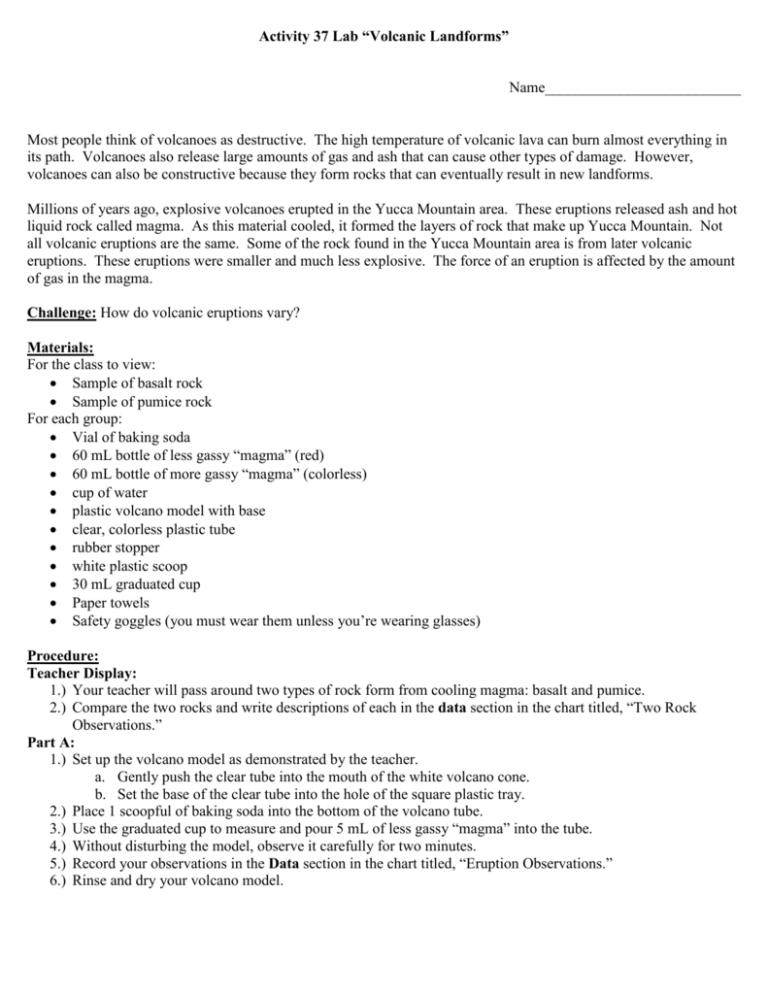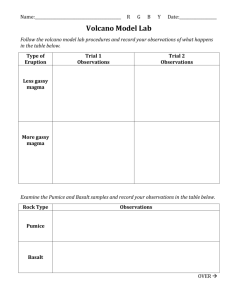Activity 37 Lab “Volcanic Landforms”
advertisement

Activity 37 Lab “Volcanic Landforms” Name__________________________ Most people think of volcanoes as destructive. The high temperature of volcanic lava can burn almost everything in its path. Volcanoes also release large amounts of gas and ash that can cause other types of damage. However, volcanoes can also be constructive because they form rocks that can eventually result in new landforms. Millions of years ago, explosive volcanoes erupted in the Yucca Mountain area. These eruptions released ash and hot liquid rock called magma. As this material cooled, it formed the layers of rock that make up Yucca Mountain. Not all volcanic eruptions are the same. Some of the rock found in the Yucca Mountain area is from later volcanic eruptions. These eruptions were smaller and much less explosive. The force of an eruption is affected by the amount of gas in the magma. Challenge: How do volcanic eruptions vary? Materials: For the class to view: Sample of basalt rock Sample of pumice rock For each group: Vial of baking soda 60 mL bottle of less gassy “magma” (red) 60 mL bottle of more gassy “magma” (colorless) cup of water plastic volcano model with base clear, colorless plastic tube rubber stopper white plastic scoop 30 mL graduated cup Paper towels Safety goggles (you must wear them unless you’re wearing glasses) Procedure: Teacher Display: 1.) Your teacher will pass around two types of rock form from cooling magma: basalt and pumice. 2.) Compare the two rocks and write descriptions of each in the data section in the chart titled, “Two Rock Observations.” Part A: 1.) Set up the volcano model as demonstrated by the teacher. a. Gently push the clear tube into the mouth of the white volcano cone. b. Set the base of the clear tube into the hole of the square plastic tray. 2.) Place 1 scoopful of baking soda into the bottom of the volcano tube. 3.) Use the graduated cup to measure and pour 5 mL of less gassy “magma” into the tube. 4.) Without disturbing the model, observe it carefully for two minutes. 5.) Record your observations in the Data section in the chart titled, “Eruption Observations.” 6.) Rinse and dry your volcano model. Part B: 1.) Use the graduated cup to measure and pour 2.5 mL of more gassy “magma” into the volcano tube. 2.) Dip your finger into water and use it to moisten the bottom of the rubber stopper. 3.) Dip the bottom of the stopper into the baking soda so that a thin layer of baking soda sticks to it. 4.) Gently cap the volcano tube with the stopper. Try not to spill any baking soda and insert the stopper snugly into the tube. 5.) Quickly turn the entire volcano model upside-down (as demonstrated by your teacher) and then put it back on the table right-side up. a. Hint: Balance the volcano model on the palm of one hand. Use the other hand to hold the stopper and tube in place. Turn the model upside-down and right-side up. Quickly set the model on the table right-side up. 6.) Without disturbing the model, observe it carefully for two minutes. 7.) Describe what you observe in the data section in the chart titled, “Eruption Observations.” Clean Up: 1.) Rinse and dry all parts of the model. 2.) Place the cap back on the “magmas.” 3.) Wash and dry the lab areas. 4.) Pick up and throw away all used paper towel. 5.) Bring all the materials back to the front of the room. Data: Observations of Two Rocks: Rock Type Observations Pumice Basalt Eruption Observations: Type of Magma Less Gassy Magma More Gassy Magma Observations Conclusions: 1.) Which magma type resulted in a quiet eruption? ___________________________ 2.) Which magma type resulted in an explosive eruption? ______________________ 3.) What causes a volcano to erupt explosively? _____________________________ 4.) Name one specific rock that would result from a gassy/explosive eruption: ____________________________________ 5.) Name one specific rock that would result from a less gassy/quiet eruption: 6.) What is the name of the rock type that comes from magma or lava? ___________ 7.) How can a volcano be destructive? _____________________________________ 8.) How can a volcano be constructive? ____________________________________ 9.) What is magma called after it reaches the surface of the earth? _______________ 10.) Name two landforms that would result from repeated volcanic eruptions: a. ____________________________________________________ b. ____________________________________________________








